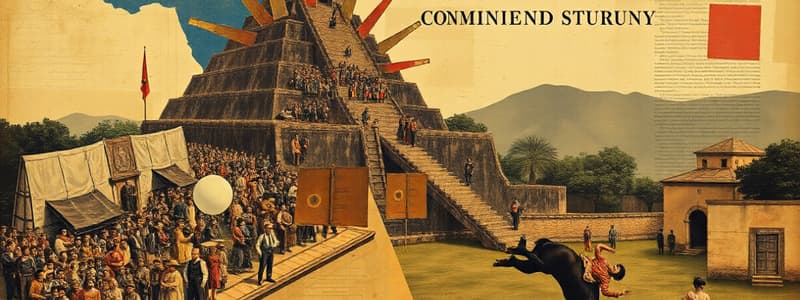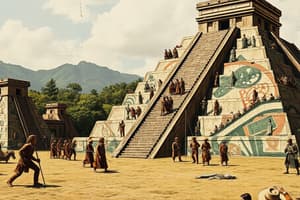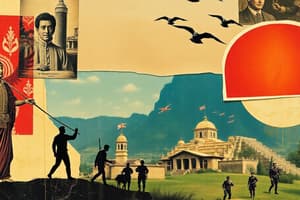Podcast
Questions and Answers
What was the primary reason the Spaniards decided to build a new city on the ruins of Tenochtitlan?
What was the primary reason the Spaniards decided to build a new city on the ruins of Tenochtitlan?
- To establish a permanent settlement (correct)
- To exploit the existing infrastructure
- To create a base for further conquests
- To honor the indigenous cultures
Which factor contributed to the hardships faced by the Spaniards during their conquest?
Which factor contributed to the hardships faced by the Spaniards during their conquest?
- They faced resistance from the Aztecs
- Many lost companions to disease and death (correct)
- They were constantly outnumbered
- They had insufficient supplies
What percentage of the treasure was typically awarded to the foot soldiers in the Spanish conquest?
What percentage of the treasure was typically awarded to the foot soldiers in the Spanish conquest?
- One-half
- One-tenth
- Three-quarters
- One-fifth (correct)
How did the mood of Cortes's companions change during the conquest?
How did the mood of Cortes's companions change during the conquest?
What was one result of the new civic and religious rituals established by the Spaniards?
What was one result of the new civic and religious rituals established by the Spaniards?
What was the initial treatment of the indigenous populations by the Spanish?
What was the initial treatment of the indigenous populations by the Spanish?
What did the encomienda system theoretically aim to accomplish?
What did the encomienda system theoretically aim to accomplish?
What was the primary method used to keep indigenous people in a state of bondage?
What was the primary method used to keep indigenous people in a state of bondage?
How did the Spanish approach the tribute from the Aztec empire?
How did the Spanish approach the tribute from the Aztec empire?
What was one of the reasons for the Spanish crown wanting to maintain direct control over the Indians?
What was one of the reasons for the Spanish crown wanting to maintain direct control over the Indians?
What drove Cortes to send expeditions in various directions after taking control of Tenochtitlan?
What drove Cortes to send expeditions in various directions after taking control of Tenochtitlan?
What was the role of the encomendero in the encomienda system?
What was the role of the encomendero in the encomienda system?
What was a significant issue with the encomienda system?
What was a significant issue with the encomienda system?
What significant event occurred in August 1521 regarding Cortes?
What significant event occurred in August 1521 regarding Cortes?
What did the encomienda system lead to in terms of social consequences for the indigenous population?
What did the encomienda system lead to in terms of social consequences for the indigenous population?
Flashcards
Slavery
Slavery
The practice of forcing people to work without pay, often under harsh conditions, for the benefit of others.
Encomienda System
Encomienda System
A system of forced labor in which native populations were assigned to Spanish colonists and forced to work on plantations or in mines.
Conquest of the Aztec Empire
Conquest of the Aztec Empire
The Spanish conquest of the Aztec Empire was a complex and bloody affair, resulting in the loss of countless lives and the destruction of a prosperous civilization.
Rebuilding of Tenochtitlan
Rebuilding of Tenochtitlan
Signup and view all the flashcards
Torture of Aztec Leaders
Torture of Aztec Leaders
Signup and view all the flashcards
Encomienda
Encomienda
Signup and view all the flashcards
Hernán Cortés
Hernán Cortés
Signup and view all the flashcards
Encomenderos
Encomenderos
Signup and view all the flashcards
Spanish Justification of the Encomienda System
Spanish Justification of the Encomienda System
Signup and view all the flashcards
The Reality of the Encomienda System
The Reality of the Encomienda System
Signup and view all the flashcards
What was the encomienda system?
What was the encomienda system?
Signup and view all the flashcards
Why did the Spanish Crown want to maintain control over the Indians?
Why did the Spanish Crown want to maintain control over the Indians?
Signup and view all the flashcards
How did Cortes expand Spanish control after conquering Tenochtitlan?
How did Cortes expand Spanish control after conquering Tenochtitlan?
Signup and view all the flashcards
What challenge did Cortes face after conquering Tenochtitlan?
What challenge did Cortes face after conquering Tenochtitlan?
Signup and view all the flashcards
What were the long-term consequences of the Spanish conquest on the Indians?
What were the long-term consequences of the Spanish conquest on the Indians?
Signup and view all the flashcards
Study Notes
- Spanish conquerors withdrew to Coyoacán, leaving the Aztecs to deal with their dead.
- Spaniards built a new city, Mexico, over Tenochtitlan's ruins.
- Indigenous laborers, directed by Spanish architects and artisans, and indigenous elites, assisted in building Mexico.
- Many aspects of pre-Hispanic daily life remained despite the new city's construction.
- Spanish officials and Franciscan friars struggled to erase indigenous cultural and celebratory practices.
- Spanish conquerors were often in debt for their journey and equipment, and many died or suffered hardships, making their rewards small.
- Foot soldiers received significantly less than the higher-ranking soldiers.
- The method of reward for conquerors was often the brutal enslavement of indigenous people.
- The encomienda system was established for rewards.
- Encomenderos (Spanish citizens) received tribute and labor from indigenous people.
- The system was seen as a way to acculturate indigenous people, but abuses like overwork, violence, and separation of families were commonplace.
- The Spanish crown wanted the tribute for themselves to maintain control over the indigenous people.
- The conflict between the crown and encomenderos dominated the 16th century.
- Spanish forces conquered Mexico, Central America, and parts of the U.S. Southwest using indigenous allies.
- Cortés used indigenous co-conquerors in thousands.
- Cortés distributed Indian towns to soldiers as rewards.
- Cortés used the Aztec tribute rolls to understand populations, geography, and the economies of subject towns.
- Early Spanish expeditions focused on exploring land resources, routes, and populations (gold, silver, and timber).
- Spanish conquest spread quickly to other parts of the New World.
- Spanish expeditions to explore land, establish communication with islands, and establish towns were common.
- A royal commission was granted to Francisco de Garay to govern lands north of Veracruz.
- Cristóbal de Olid was sent to western Mexico.
- Expeditions were undertaken in search of rumored fabulously rich cities.
- Myths such as the Seven Golden Cities of Cibola, and Amazons, inspired expeditions.
- Pánfilo de Narváez led an expedition to Florida in 1528 (lost his men and ships).
- Alvar Núñez Cabeza de Vaca was one of four survivors of Narváez's expedition.
- Marcos de Niza, a Franciscan, led an expedition to search for Cibola and was instrumental to the Coronado expedition.
- Francisco Vázquez de Coronado led an expedition in 1540 searching for Cibola and Quivira; this expedition encountered some Zuni settlements in the present-day American Southwest.
- Coronado's expedition met with difficulties from indigenous populations, unreliable information, and a lack of resources and supplies.
- The Spanish faced numerous obstacles in their expansion into Mexico, such as difficult terrain (mountains, valleys, and forests) and varying climates in different regions.
- Climate variations, especially rainfall and temperature, influenced the Spanish conquest.
- Highly centralized states, relying on a capital, were more vulnerable to Spanish conquest.
- Cortez faced accusations of corruption and mistreatment of indigenous peoples and was removed from his governorship.
- The Spanish crown created a governing council, the Council of the Indies, in 1524 to govern the Spanish colonies in the New World, and the Casa de Contratación in 1503 to oversee trade.
- The Audiencia of Santo Domingo and Mexico were Courts of Justice initially, but in the New World they developed into executive and legislative branches.
- The New Laws of 1542-43 attempted to limit encomienda abuses and protect indigenous people.
- Encomienda system was significantly modified, ultimately to be phased out.
- Instability and conflict continued between the Spanish crown and conquistadors, and amongst indigenous groups.
Studying That Suits You
Use AI to generate personalized quizzes and flashcards to suit your learning preferences.
Related Documents
Description
Explore the complex dynamics following the Spanish conquest of Mexico, particularly the establishment of the new city over Tenochtitlan's ruins. This quiz delves into the roles of indigenous laborers, the encomienda system, and the cultural struggles faced by the Spaniards and indigenous populations. Test your knowledge on the interactions between cultures during this transformative period.





